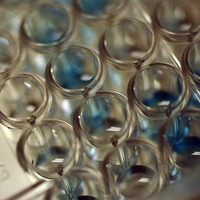Question:
Improve your pipetting techniques to get accurate results when working with apoptosis assays
The Protein Man Says:
Accurate pipetting is of vital importance when working with apoptosis assays or any laboratory experiments since failure to do so may compromise the integrity of your results. So, how can you reduce both random and systematic errors when handling liquids in the laboratory? Well, the answer lies in understanding how these precision micro-instruments work and practicing good pipetting techniques.
 How to Improve Your Pipetting Technique
How to Improve Your Pipetting Technique
The accuracy of these precision micro-instruments depends on how you use them. As such, you need to develop good pipetting techniques to make sure you deliver the optimal level of precision and accuracy your experimentations demand. How do you do it? Here are some useful tips that you may want to consider:
Understand how your pipettes work.When using an air displacement pipette, you need to understand that the accuracy of your instrument may be affected by temperature, pressure and contamination. Considering its limitations, you may want to start using positive displacement pipettes which are more accurate and more suitable for use with corrosive and/or bio-hazardous materials.
Take good care of your instruments.Clean your pipettes using a wipe with 70% ethanol before using them and check them daily for any visible signs of damage to the nose of the barrel. Remember to have them serviced by an experienced pipette doctor every 6 to 12 months.
Use them properly.Make sure you observe the proper pipetting techniques and use well-fitting tips to improve your accuracy. For best results, hold your pipette vertically, use slow, smooth action when drawing liquid in and dispense the liquid along the sidewall of the receiving vessel. Make sure that the tip is not completely immersed to prevent coating the outside of the tip with liquid. You should also avoid putting the pipette on its side if there are traces of liquid on its tip since this may corrode the barrel.
Learn how to increase your accuracy.Remember to pre-wet the tip when measuring volumes greater than 10 microliters and use reverse pipetting techniques when working with volatile solvents and/or viscous liquids to improve your accuracy.
In reverse pipetting, the piston is pushed down to the purge position before drawing the liquid. When the liquid is dispensed by pushing the piston all the way down to the aspirate position, the extra liquid will be left on the tip of the instrument. This will automatically pre-wet the tip and provide better accuracy when measuring volatile solvents which easily evaporate into the air cushion.
You should also take the ambient temperature and sample temperature into account. Remember, your pipette is calibrated at room temperature so working in colder temperatures may affect the accuracy of your results.
Follow these tips and you will surely improve your pipetting techniques and get more accurate results when working with your apoptosis assays!
Image By - M i x y






